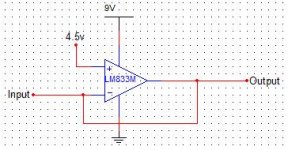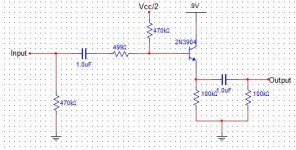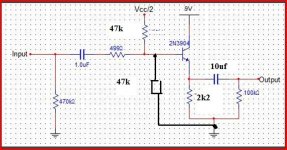Hi,
when looking in Operational Amplifier (such as LM833) data sheet , can see that power band width is constant in the audio frequency region.
when passing guitar signal through buffer (consists from LM833 or any similar), high frequency loss is noticed, can any body explain why is that??
when looking in Operational Amplifier (such as LM833) data sheet , can see that power band width is constant in the audio frequency region.
when passing guitar signal through buffer (consists from LM833 or any similar), high frequency loss is noticed, can any body explain why is that??
yep the input impedance is much higher then guitars (about 10k),but why should it infect the high freqs?
What would you suggest?
I had attached another buffer in BJT version, also with the high freq problem
I had attached another buffer in BJT version, also with the high freq problem
Or try this,
the emmiter resistor needs to be low to give decent output current capability.
The base need to be given a reference voltage of VCC/2 approximately hence the two 47k resistors. The output cap needs to be fairly large to ensure no LF roll off into low impedance loads.
In your opamp above the LM833 isn't ideal for a 9volt (battery ?) Try a TLO71 (single) or TL072 (dual)
the emmiter resistor needs to be low to give decent output current capability.
The base need to be given a reference voltage of VCC/2 approximately hence the two 47k resistors. The output cap needs to be fairly large to ensure no LF roll off into low impedance loads.
In your opamp above the LM833 isn't ideal for a 9volt (battery ?) Try a TLO71 (single) or TL072 (dual)
Attachments
The bjt shouldn't lose highs as you put it. Are you certain the transistor is connected correctly ?
It should drive any normal preamp/power amp input OK
The voltage on the base should be around 4.5 and with around 4 volts on the emmiter if using 9 volt supply.
It should drive any normal preamp/power amp input OK
The voltage on the base should be around 4.5 and with around 4 volts on the emmiter if using 9 volt supply.
Yes' Vcc is 9v battery,why should it matter which OpAmp (LM833, TL071, LM5532, I was looking for low noise & low dist)?
LM833/NE5532 are a bit power hungry compared to TLO72.
Noise and distortion tbh is the last to worry over here. Noise is also determined by the surrounding components and the values used... honestly, it's a non problem for you here... same goes for distortion. The NE5532 is preferable for driving low impedance loads <2k
Your battery will last several times longer with the TL072... and if battery life is very important there is the low power TL062 (not as well specced).
Noise and distortion tbh is the last to worry over here. Noise is also determined by the surrounding components and the values used... honestly, it's a non problem for you here... same goes for distortion. The NE5532 is preferable for driving low impedance loads <2k
Your battery will last several times longer with the TL072... and if battery life is very important there is the low power TL062 (not as well specced).
"Noise is also determined by the surrounding components and the values used..."
What design rules should I follow to avoid noises?
What design rules should I follow to avoid noises?
General rule is to keep impedances as low as practicable... more so for bjt devices (such as the NE5532). FET opamps work well at mid impedances such as 20k feedback/input resistance.
Now put it all in perspective... you won't notice any sudden increase in noise swapping from a 5532 using 1k resistors to a TL072 using 47 or 100k.
Yes in theory and practice the noise does increase... but it's all down in the -110db range or thereabouts anyway where a few db just doesn't matter to all practical purposes.
Of far far more importance is construction/layout and the power supply... honest 🙂
Now put it all in perspective... you won't notice any sudden increase in noise swapping from a 5532 using 1k resistors to a TL072 using 47 or 100k.
Yes in theory and practice the noise does increase... but it's all down in the -110db range or thereabouts anyway where a few db just doesn't matter to all practical purposes.
Of far far more importance is construction/layout and the power supply... honest 🙂
If you can get hold of a copy of this, it will be one of the best investments you can make,
The Audio Power Amplifier Design Handbook
The Audio Power Amplifier Design Handbook
- Status
- Not open for further replies.
- Home
- Design & Build
- Construction Tips
- Buffers high freq loss



